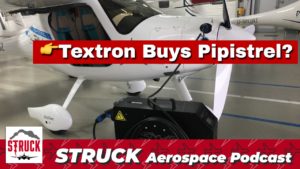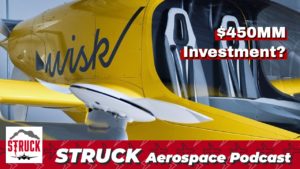In this episode of the Struck Aerospace Engineering Podcast, we discuss how the GAO is talking with Boeing about their aging workforce – half of Boeing FAA delegates will be of retirement age in just 5 years, which is worrisome. The Eurocopter X3 broke the speed record for a helicopter, and is an impressive machine. We discuss the Beta Technologies EVTOL making an important flight, Eviation getting a new partner on composite doors plus much more on this episode.
Learn more about Weather Guard StrikeTape segmented lightning diverters. Follow the show on YouTube, Twitter, Linkedin and visit us on the web. Have a question we can answer on the show? Email us!
Podcast: Play in new window | Download
Transcript: EP35 – Boeing vs GAO, Eviation Partners on Composites; Eurocopter X3 Breaks Helicopter Speed Record
This episode is brought to you by Weather Guard Lightening Tech. At Weather Guard, we support design engineers and make lightning protection easy.
You are listening to the struck podcast. I’m Dan Blewett. I’m Allen Hall. And here on struck, we talk about everything aviation, aerospace engineering, and lightening protection.
All right. Welcome back to the struck aerospace engineering podcast on today’s episode. In our new segment, we’re gonna talk about easy jet. There was a lightning strike that caused that flight to be diverted kind of scary, but everyone was okay. Secondly, we’re talking about the FAA did GAO here in the U S has talked about that.
A lot of, uh, engineers are going to be hitting retirement age pretty soon, and there’s some key training and competency gaps that need to be addressed. It’s a really interesting topic right there. Uh, we’re going to chat a little bit about Boeing and some of their UV technology and other technologies they’ve developed to help clean airplanes.
Obviously COVID is still affecting a lot of the way we travel. And speaking of the way COVID is affecting travel. Australia has some new protocols potentially, uh, in place soon that will keep, uh, honestly passengers pretty happy, but also make screening a lot easier and safer potentially in our engineering segment.
We’re going to talk about the, uh, the Eurocopter X3, which has set a new speed record for a helicopter and also the supersonic business jet that just went through wind tunnel testing. And then lastly, in our EVTOL segment, we’re going to talk about Eviation, uh, getting a partner for composite doors and lastly, the Beta Technologies EVTOL and a flight test they recently completed.
So Allen let’s talk first with some lightning news, easy jet. They think they got struck by lightning. But take us through that scenario. What happened? Well, there’s, there’s, there’s a lot happening in this particular one. So it’s flying from, uh, essentially Scotland down to Southern England. And there was a lightning strike on the communication tower down and in Bristol.
And what happens in a lot of cases, this is not a normal, but when lightning strikes the airport, you can lose airport lighting, which is a big deal, or you can lose communication tower. And when you lose communication to the aircraft that are coming in to the airport, uh, you. You lose control of traffic.
So you, you probably will end up diverting somewhere, which is what happened. They ended up diverting to Birmingham and then being bust the bus down at night time to where they needed to go. So a lot of the airports though have lightning protection because this is not infrequent and a lot of the gear.
Uh, communications gear and, uh, anything that may be susceptible to lightning strike has protection in it. So it makes you think something happened, uh, loss of power loss piece of damaged equipment, which just makes for a fun flight because you’re not expecting that to happen. If you know, usually aircraft gets struck not, not the airport, but the airport gets struck in this case.
It made it for a little bit of an adventure. So bigger story here. The FAA has said that while they’re going to work to address some gaps, but the GAO is sort of a wag, their finger in, and this is the government accountability office is recommending the FAA, really address some, some issues that are going to be upcoming.
So in 2025, According to the GAO between 52 and 62% of FAA inspectors and engineers will be retirement eligible. So, Alan, why is that a scary scenario? And why does that require this, uh, this need to be addressed? Well, the FAA is involved in all parts of aviation in the United States and across the world.
And, and if you’re losing half of your. Staff, so to speak, you can’t operate things, just school grind to a halt, which is what will happen. And it’s hard to replace that sort of, that level of expertise that has developed at the FAA over 30 years, probably. Maybe 40 somewhere in there. And so to take those key knowledgeable people that have been, uh, working with the aircraft industry for such a long period of time off the table, you’re just left with this void.
And, and the problem comes about because it’s very S the aircraft industry is very cyclical. And so there’s booms and busts. It’s kind of like the oil industry, there’s booms and busts. And during those bus period, people don’t get hired. And so you get these, this, uh, wide span of several years where the aircraft finished, she wasn’t hiring.
If they’re not hiring engineers and inspectors, that’s where lolly FAA gets their people from us, from the aviation industry. So if the, of age innovation industry, isn’t hiring people in that, in that span of time, then there’s just like this, this, this void of people that exist. So for the next wave of. Of engineers and inspectors.
It could be, that could be a 10 to 15 year gap in terms of, if you look at the statistics and the age distribution, you’re going to see this separation that occurs between them and it occurs. They are car companies too. You can see it. So this, this, if it’s happening in the FAA, it’s happening at the aircraft companies too, which is you just got this, this sort of knowledge that’s walking away and retiring and going down to sunny, Florida or wherever they’re headed to.
And then what are you going to do? Right? You can’t backfill 20 years of knowledge tomorrow. There just aren’t people that to fill it in because once those, once they had that dip in aviation, Th th those engineers, when somebody else and those inspectors went somewhere else to have a nice life and that you just can’t bring them back.
And it’s really hard, especially in disciplines like mine, uh, and, and some stress and mechanical systems that are very, very, very narrowly focused in the sense of they’re. They know a lot about this particular aspect of aircraft design to certification. Those people are hard to find. So you just, you just can’t pick them up off the street anywhere.
It’s going to be a real, real problem. It’s because 50% is a huge number. Holy moly. Wow. Well, and so there’ll be eligible for retirement at that point, but does that mean that they all will? I mean, do you, are you engine engineer, folk who, you know, you’re good at what you do and you’re passionate about all the, the design and tinkering like engineers or certain types of people.
I mean, Do engineers just like want to run into retirement, right? When they’re first eligible or are you sort of more of the demographic that’s maybe going to work a little bit longer? Again, it’s a, it’s a demographic, uh, profile, I think just based on my anecdotal information. If, if you put your time in government service, by the time you reach retirement age, the benefits are really good.
Uh, because you put all that, like the time it’s like being a police officer, a fireman, and at the end, there is significant benefits to staying on that job for a certain length of time. So when you get to retirement age, you pretty much want to take that if you can. It’s not like, um, You know, slept like me that are off doing their own independent engineering thing, where if you like it, you stay because you can sort of control your destiny, you know, coming into an office, so to speak, uh, or somebody else’s the boss, I’m the boss of the thing.
So, you know, a lot of people in my situation that are DER’s. Stick around until 75, 80 a lot of times because they enjoy it, you know, and, and it’s, they can come and come and go as they please work when you right. They can come and go as they please, what you can’t really do that if you’re coming to the FAA office, you know, you’re, you’re, it’s an eight to five, Monday through Friday kind of job.
And, and a lot of people when they get to the early sixties, decided to retire. And, uh, and so if they’re projecting out 50 percentile at 2025, it’s going to be roughly that it won’t be 10%. It’ll be closer to 50, so they’re not hanging, they’re not hanging. Right. They did their time. And rightly so they can.
Part of the, part of the agreement they made
moving on Boeing is talking about some of their new technology, which this obviously very relevant, just trying to keep planes as, uh, as clean as possible. So their engineers have created a device and ultraviolet wand that they just basically like scan your carrier all through the plane and yeah. Zaps everything out of the nooks and crannies.
And, um, it’s pretty interesting. I mean, I guess my bigger question here is not whether this stuff works. It seems like it clearly does. Uh, but is this going to hang around in three years, like in three years still going to be doing this or, or not? That is a great question. And I was having this discussion over the weekend with somebody about all the cleanliness activities that are happening on the airplanes today.
And how, at least in the United States, there’s a lot of discussion how the, the general flu hasn’t propagated, like it normally would at this time of year. So they’ve seen a real big drop in and flu related interest issues. Right. And, uh, um, Guessing there just based on the level of concern you hear about COVID on airplanes, you would have to assume that the flu and the common cold transmissions on airplanes would be a thing and probably a relatively common thing.
Uh, so do we keep their level of cleanliness on the airplanes, uh, to mitigate the transmission of diseases in general? Nate, there’s a whole bunch of them. Uh, do we keep that level of cleanliness up or as soon as COVID is over, we just go back to whatever lifestyle we’re living to begin with. I don’t know.
You know, I think because the airline industry is going to be hurt, so. Badly in this and the aircraft manufacturers can be hurt so badly. The more they can do to make the aircraft sterile on us, in a sense, it’s going to make the aircraft more, uh, amenable to being sold. And if I have an air, if I have an 83 20 without an antibacterial antiviral system, and I get eight, three 20 with antiviral system, and it’s say it’s $10,000 more probably going to get the antivirus airplane.
Probably going to do that. And so the aircraft manufacturers really need to think about that because I think the, the, the wand system that Boeing has, uh, proposed and, uh, Honeywell, I think has this sort of cart related, uh, system that goes down the down the cabin, both of those are very, uh, useful tools.
But realistically, that kind of light technology committee integrated right into the aircraft to start off with. So as you lift the aircraft for the night, you flick the switch and it self cleans itself. Right. And just, yeah, just the self up and you’re done and you’re done the next morning, come in here, it’s all quote, unquote sanitized or taking all the viruses out of it.
And you’re off for the next next day that I think is going to become more and more reality. The question is. Does that technology, which exists in the aerospace industry, then get transferred on to other things like subways and buses and cars. Because if things that start off an aircraft have a tendency to flow down over time and governments, governments that get into sort of a panic mode and rightly so there.
People are scared right now. Uh, we’ll start to edict things like this. Like if we can do it on an airplane, why kind of do it on the bus. If I can, I can transmit COBIT on an airplane. You can sure as heck transforming it on a subway. How hard is it to put UV lights in the subway system? Really not hard. So I think some of this technology is going to trickle down.
Don’t know what you think. So many, you take the subway way more than I do. Wouldn’t it make sense to have it? Yeah, I was on it today. Um, I, it would, I think, well, obviously the air filtration systems are not nearly as robust, probably not even in the same ballpark as on an airplane. Right. Um, Yeah. So I, I kind of am on the fence of whether as soon as we get the chance where we’re like, why are we doing this?
Like, no, one’s sick anymore. This is costing us $30 million a year in cleaning fees. Like let’s ax that, so our shareholder value goes up. Right? I think it’s song at some point a CEO is like looking through ways to increase the stock price and get his $15 million bonus. And he’s like, Hey. It doesn’t seem like we really need all that cleaning anymore.
Smell ya. Right. But then again, you know, trying to ward off future pandemics and problems, it seems like it would make good sense if we could just integrate all this stuff, like you said, into the subway system, into the, every public place, or it’s just probably, we’re going to be a little more insulated from the next pandemic and just the next flu season.
And maybe this is just good for the economy and the city in general, going forward. That seems to make sense, but I don’t, I don’t know. I don’t know that I trust humans to make that choice. Because they’re going to see it as an expense where it’s like, well, we’re spending all this money, but how do we know we’re actually preventing anything because you can’t really measure prevention, right?
Like you spent $30 million a year on something. And the thing that you’re preventing doesn’t happen. But you don’t have any way to know if it would have happened, if you didn’t spend the money. Right. And that’s kind of how we operate, but then you start to like throttle it back and then see when it becomes a problem again.
Yeah. I agree with that. But we have been through several in the last 10 years, ish, we’ve been through several of these pandemics, not ones that have been as, uh, spread as fast as it has been as deadly, but swine flu. And, uh, there’s been a number of them. And so, so we know. Every three-ish years for us years, five years is going to be another one.
And it isn’t like it’s never going to happen again. No is saying that everybody is saying, yeah, every couple of years you’re going to be in this sort of pandemic because we’re all interconnected and we’re all moving around so much anymore. So it’s easy to transmit. But, um, I think the first market is going to be business aircraft.
They’re going to do it first because that’s, what’s going to happen, then it’s going to be the larger aircraft. And then hopefully he gets down to buses and subways. That’s the hope. Yeah, absolutely. Well, speaking of which Australia is maybe their first to report that their whole, so processes just going to change, which is sounds great.
So basically their thing is they’ve been, they’re installing computerized tomography equipment, which basically says like all your electronics and you all the stupid stuff in your bag, they make you take out as he’s just going to be able to stay in your bag. So it’s just all going to go through those scanner.
And they don’t have to worry about, you know, any of that. And I guess the only challenges we have to know which passenger goes with which bag. So we’ll have to be a little more regimented rather than everyone just like shoving their stuff through and then we’ll think through. But that sounds wonderful.
So go COVID no more, I have TSA pre-check so I don’t have to really suffer through much of that anyway, but this seems like a good. Good system. Well, they have done it in the United States. At least in some places I went through Newark airport several years ago, where that happened, where they said, keep your shoes on, keep your stuff in your bag.
Don’t take it out. Don’t take your liquids out, just put it through the scanner. And that was it. And I, and I don’t know, I don’t go through Newark enough to know if this is just a. A day-to-day thing now, or it was just a special test that was going on during that time period. I had to be traveling, but it seems like there’s some technology out there that allow it to happen.
And it’s probably just more expensive, but in this new COVID world where we don’t want to touch things, then it makes a lot more sense. Because if you start thinking about the number of touches you make. At an airport or any place else on a subway. Even there’s a lot of touches that are not needed in today’s world.
And if we can minimize those, it would help because it seems like a lot of the transmission. Well, in the COVID case, there’s just, there’s the seems to be airborne. But some of it is transmitted via surfaces. So, uh, and but all in all, it makes the time. By the time I enter the terminal to the time I get on the airplane, shorter, that is a huge benefit.
That’s a huge benefit. It’ll encourage people to use those rooms.
Right? So in our engineering segment today, we’ve got two very fast. Aircraft. So one’s a rotocraft, one’s an aircraft. Uh, the Eurocopter X three, and this is a behemoth just broke. The speed record was a 263 knots I think is the previous record was two 50, uh, very bulky. So w. What is the deal with the X three?
How has it so fast? What is the engineering involved to make this happen? If you think about a helicopter being shaped like a Guppy, it’s sort of shaped like that it has a sort of belly to it and they needed that because there’s, there’s two propellors on a, basically a short stubby wing. Coming out the sides of the fuselage.
So it’s got the main rotor. There’s no tail rotors to speak of. And it’s got these two propellers gear-driven on either side of the rotorcraft. Uh, so it, it looks like an EVT AOL sort of, but it’s not, obviously it’s, it’s driven by, uh, standard, uh, aviation fuels, but. It moves really, really quickly. And the two propellors on the act as, um, like a normal tail rotor would be.
So there, once it’s, it’s, it’s sort of helping, uh, to, uh, kind of rotate the helicopter has a main road or spin. So instead of a terabyte or they’ve kind of taken care of that, and the two propellors that are facing forward, it has gone tremendously fast. Uh, and it. Really, it always, all this depends on fuel burn and efficiency and all those sort of things, but they’re the person that boundaries on, they are dynamic side.
And then you start to wonder like, man, is, is price wise, can they get it down to things like a King air, which is a. Twin engine and turbo prop, or is it, uh, to bowl replacement for sort of the tiltrotor or six Oh nine kind of, uh, uh, aircraft. It, there there’s so much happening so quickly. And so of course has been in this space for a little while, too, and so much happened on the rotorcraft side and sort of for thrust and, and getting the speeds way up, it starts to encroach on the airplane territory.
So it’s going to be really interesting to watch go forward. Well, who, who wants a, uh, helicopter this fast? Who needs a helicopter as fast as a purely military? No, I’m like, what is it who buys it? Uh, well, people who fly in helicopters and there’s a lot of them, uh, obviously an industrial use off shore or old platforms.
There’s helicopters going back and forth. There’s no other way to do that. Uh, but there’s also that, uh, New York too. Um, Philadelphia route or New York to New Jersey helicopters, which does, if this don’t move that fast helicopters are vertical things and they just don’t fly at great speeds for a variety of different reasons.
So if you can have a versatile take off, you know, I can land anywhere and it was just the beauty of the Silicon Valley. I can land anywhere, but I can fly at turbo prop speeds. Well, okay. Your marketplace just explodes in terms of the number of possibilities now, because now I don’t have to go to the airport.
I can put this at my local, at my business. I can put this at the hospital. I don’t have to drive organ transplants to the hospital, to the airport, to fly for they’re going to go. I can actually do it right at the hospital and go from a to B directly, which is part of what the VTO market is trying to hit too.
So there’s going to be a really fun competition going forward on what the technology is to fill that market place, because. Fast flying a vertical takeoff, a landing is a dream that we really haven’t reached yet, and which is what the six Oh nine was trying to do and will do. But there is a variety of different places that this can be used.
And I think that they’ll help. They’ll definitely find a big marketplace for it. So speaking of really fast, uh, Toys or business toys or, you know, whatever toys, uh, Arion completed, wind tunnel testing of their supersonic business jet, the . So how, I mean, there’s a lot of fast things happening right now. Um, I mean, this thing is $120 million aircraft, 12 seats, supersonic business jet, and they are hoping that it will fly in 2023.
So, what are your thoughts here? I think they’re going to run into difficulty on the political side. The technology we’ve been flying supersonic since the forties and the Concorde was in the 1970s. So this, this aircraft will happen and it has a variety of great features that keep the, the Sonic boom down and be efficient and do all the things that a more modern supersonic business aircraft needs to go do.
But there has been, uh, you know, if there is the expected change in leadership in the United States, uh, the last time that happened business aircraft got crushed, absolutely crushed because the, the administration made a point of calling out, calling out companies that had airplanes and it would, it would take all of us.
Uh, five seconds for a politician to come out and blast companies for buying a supersonic business jet for the CEOs can go fly to Paris for the weekend that will take no time to do so. You really need to be. Thinking not only about the engineering right now, you need to be thinking about the politics and making sure that you don’t get blown out of the water because some politician wants to take a free swing.
And I think there’s a lot of, uh, I would be really concerned right now. Uh, I know a lot of these projects are happening in. Um, we’re conservative areas like Florida, which will be our big proponent of these, of these aircraft. But on the broader scheme, you got to get it through the FAA. You got to get through a number of other hurdles.
Can you do that? If the politics change and you become, um, An object to, to beat upon. That’s going to be the real, real struggle here, because I know, I know the engineer, a lot of the engineers that are working on these projects, they’re going to get this done. This is going to happen. This will be the future.
Now, will it be a future in two years or just got to wait four or six or eight before the government allows it to happen? That’s going to be the thing to really watch. All right. So in our final segment today, we’re going to chat a little bit about electric, vertical, takeoff, and landing. So these vehicles are continuing to be really fascinating and seeing their development and their sort of race to, to certification.
So, uh, just some news this week about, uh, obviously every ounce matters right on these planes. And so elevation is partnering with altitude aerospace, um, to help develop composite doors. So Alma, this seems like, kind of like a boring article ago. We got news about their doors, but this is actually pretty significant as far as again, like every.
Graham matters, right? Yes, it does on an aircraft absolutely mean it just makes it more efficient, right? So you, anywhere you can save weight on an aircraft, you’re going to do it. And even even old aircraft quote, unquote old aircraft are looking for a constant weight savings every year. It’s, they’re just grinding and grinding and grinding to get weight off the aircraft.
So any really mundane change like this is the engineer’s like super excited that they save five pounds. It’ll be dancing in the parking lots after work. And that’s, that’s why, because it’s such a big driver on performance. Weight is performance and less weight is better performance. This is why you get into these weird discussions about weight all the time.
You’re just trying to out. Yup. Tronick out compete the next guy on the airplane. And if you can cut the weight down, it makes a huge, huge difference. All right. So last thing on the docket today. Uh, beta technologies has done a recent test flight. So this was in Plattsburgh, New York and Alan what’s what’s sticks out of you has significant about this.
Uh, well, this test flight, it’s flying what to do. Can they? Yeah, so they’re in, they’re based in Burlington, Vermont, uh, and they’re flying in Plattsburgh, New York. And so there’s, there’s a big airport, but it’s, it’s a little bit of a haul from, from, uh, Vermont to New York because the Plattsburgh New York is essentially on the Canadian border.
It’s a stone store away from the Canadian border. So it’s way up North Northern New York. Uh, the. The aircraft was lifted via helicopter from Burlington, Vermont, and carry it up to Plattsburgh to do the flight test. I think as it goes, the, in Plattsburgh, there’s a there’s water out there and they can do flight testing over the water, all they want and at the airport and the runway, there is huge if I remember correctly so that they have a great place to do flight testing, but it looks like they’re doing just basically Ford flight right now and getting off the ground and landing, which is fantastic.
All right. Well, that’ll do it for today’s episode of struck. If you’re new to the show. Thank you so much for listening. And please leave a review and subscribe on iTunes, Spotify, or wherever you listen to podcasts. Check out the weather guard, lightening tech YouTube channel for video episodes, full interviews and short clips from the show.
And follow us on LinkedIn, Twitter, Instagram, and Facebook. Our handle is @WGlightning tune in next Tuesday for another great episode on aviation, aerospace engineering and lightening protection.
StrikeTape, weather guard, lightning techs, proprietary lightning protection for radomes provides unmatched durability for years to come. If you need help with your radon lightning protection, reach out to us at weather guard. eero.com. That’s weatherguardaero.com.












